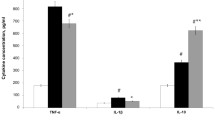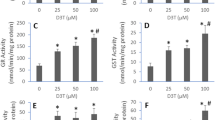Abstract
The role of protein kinases p38 and CK2 (casein kinase II) in the response of RAW 264.7 macrophages to the lipopolysaccharide (LPS) from gram-negative bacteria was studied. Using specific p38 and CK2 inhibitors (p38 MAP kinase Inhibitor XI and casein kinase II Inhibitor III, respectively), we investigated the effects of these protein kinases on (i) LPS-induced activation of signaling pathways involving nuclear factor κB (NF-κB), stress-activated protein kinase/c-Jun N-terminal kinase (SAPK/JNK), p38, and interferon regulatory factor 3 (IRF3); (ii) expression of Toll-like receptor 4 (TLR4) and inducible heat-shock proteins HSP72 and HSP90; and (iii) production of interleukins IL-1α, IL-1β, IL-6, tumor necrosis factor α, and IL-10. Activation of the proapoptotic signaling in the macrophages was evaluated from the ratio between the active and inactive caspase-3 forms and p53 phosphorylation. Six hours after LPS addition (2.5 μg/ml) to RAW 264.7 cells, activation of the TLR4 signaling pathways was observed that was accompanied by a significant increase in phosphorylation of IκB kinase α/β, NF-κB (at both Ser536 and Ser276), p38, JNK, and IRF3. Other effects of macrophage incubation with LPS were an increase in the contents of TLR4, inducible heat-shock proteins (HSPs), and pro- and anti-inflammatory cytokines, as well as slight activation of the pro-apoptotic signaling in the cells. Using inhibitor analysis, we found that during the early response of macrophages to the LPS, both CK2 and p38 modulate activation of MAP kinase and NF-κB signaling pathways and p65 phosphorylation at Ser276/Ser536 and cause accumulation of HSP72, HSP90 and the LPS-recognizing receptor TLR4. Suppression of the p38 MAP kinase and CK2 activities by specific inhibitors (Inhibitor XI and Inhibitor III, respectively) resulted in the impairment of the macrophage effector function manifested as a decrease in the production of the early-response proinflammatory cytokines and disbalance between the pro- and anti-apoptotic signaling pathways leading presumably to apoptosis development. Taken together, our data indicate the inefficiency of therapeutic application of p38 and CK2 inhibitors during the early stages of inflammatory response.
Similar content being viewed by others

Explore related subjects
Discover the latest articles and news from researchers in related subjects, suggested using machine learning.Abbreviations
- CK2:
-
casein kinase II
- HSP:
-
heat shock protein
- IFN:
-
interferon
- IκB:
-
inhibitor of NF-κB
- IKK:
-
IκB kinase
- IL:
-
interleukin
- IRF:
-
interferon regulatory factor
- JNK:
-
c-Jun N-terminal kinase
- LPS:
-
lipopolysaccharide
- MAPK:
-
mitogen-activated protein kinase
- NF-κB:
-
nuclear factor κB
- TLR:
-
Toll-like receptor
- TNF:
-
tumor necrosis factor
References
Medzhitov, R. (2010) Inflammation 2010: new adventures of an old flame, Cell, 140, 771–776.
Morris, M. C., Gilliam, E. A., and Li, L. (2015) Innate immune programming by endotoxin and its pathological consequences, Front. Immunol., 5, 680.
Muralidharan, S., and Mandrekar, P. (2013) Cellular stress response and innate immune signaling: integrating path-ways in host defense and inflammation, J. Leukoc. Biol., 94, 1167–1184.
Takeda, K., and Akira, S. (2005) TLR signaling pathways, Semin. Immunol., 16, 3–9.
Kumar, A., Takada, Y., Boriek, A. M., and Agarwal, B. B. (2004) Nuclear factor κB: its role in health and disease, J. Mol. Med. (Berl.), 82, 434–448.
Glushkova, O. V., Parfenyuk, S. B., Khrenov, M. O., Novoselova, T. V., Lunin, S. M., Fesenko, E. E., and Novoselova, E. G. (2013) Inhibitors of TLR4, NF-κB, and SAPK/JNK signaling reduce the toxic effect of lipopolysaccharide on RAW 264.7 cells, J. Immunotoxicol., 10, 133–140.
Litchfield, D. W. (2003) Protein kinase CK2: structure, regulation and role in cellular decisions of life and death, Biochem. J., 369, 1–15.
Montenarh, M. (2014) Protein kinase CK2 and angiogene-sis, Adv. Clin. Exp. Med., 23, 153–158.
Yu, M., Yeh, J., and Van Waes, C. (2006) Protein kinase casein kinase 2 mediates inhibitor-kappaB kinase and aber-rant nuclear factor-kappaB activation by serum factor(s) in head and neck squamous carcinoma cells, Cancer Res., 66, 6722–6731.
Venerando, A., Ruzzene, M., and Pinna, L. A. (2014) Casein kinase: the triple meaning of a misnomer, Biochem. J., 460, 141–156.
Romieu-Mourez, R., Landesman-Bollag, E., Seldin, D. C., and Sonenshein, G. E. (2002) Protein kinase CK2 pro-motes aberrant activation of nuclear factor-kappaB, trans-formed phenotype, and survival of breast cancer cells, Cancer Res., 62, 6770–6778.
Dominguez, I., Sonenshein, G. E., and Seldin, D. C. (2009) Protein kinase CK2 in health and disease: CK2 and its role in Wnt and NF-kappaB signaling: linking develop-ment and cancer, Cell. Mol. Life Sci., 66, 1850–1857.
Volodina, Y. L., and Shtil, A. A. (2012) Casein kinase 2 is a universal regulator of cell survival, Mol. Biol., 46, 423–433.
Christian, F., Smith, E. L., and Carmody, R. J. (2016) The regulation of NF-кB subunits by phosphorylation, Cells, 5; doi: 10.3390/cells5010012.
Bode, J. G., Ehlting, C., and Haussinger, D. (2012) The macrophage response towards LPS and its control through the p38(MAPK)-STAT3 axis, Cell. Signal., 24, 1185–1194.
Zarubin, T., and Han, J. (2005) Activation and signaling of the p38 MAP kinase pathway, Cell Res., 15, 11–18.
Cuadrado, A., and Nebreda, A. R. (2010) Mechanisms and functions of p38 MAPK signaling, Biochem. J., 429, 403–417.
Glushkova, O. V., Khrenov, M. O., Novoselova, T. V., Lunin, S. M., Fesenko, E. E., and Novoselova, E. G. (2015) The role of CK2 protein kinase in stress response of RAW 264.7 macrophages, Dokl. Biol. Sci., 464, 260–262.
Allende, J. E., and Allende, C. C. (1995) Protein kinase CK2: an enzyme with multiple substrates and a puzzling regulation, FASEB J., 9, 313–323.
Kato, T., Jr., Delhase, M., Hoffmann, A., and Karin, M. (2003) CK2 is a C-terminal IkappaB kinase responsible for NF-kappaB activation during the UV response, Mol. Cell, 12, 829–839.
Scaglioni, P. P., Yung, T. M., Cai, L. F., Erdjument-Bromage, H., Kaufman, A. J., Singh, B., Teruya-Feldstein, J., Tempst, P., and Pandolfi, P. P. (2006) A CK2-dependent mechanism for degradation of the PML tumor suppressor, Cell, 126, 269–283.
Tsuchiya, Y., Asano, T., Nakayama, K., Kato, T., Jr., Karin, M., and Kamata, H. (2010) Nuclear IKKbeta is an adaptorprotein for IkappaBalpha ubiquitination and degradation in UV-induced NF-kappaB activation, Mol. Cell, 39, 570–582.
Terazawa, S., Mori, S., Nakajima, H., Yasuda, M., and Imokawa, G. (2015) The UVB-stimulated expression of transglutaminase 1 is mediated predominantly via the NFκB signaling pathway: new evidence of its significant attenuation through the specific interruption of the p38/MSK1/NFкBp65 Ser276 axis, PLoS One, 10, e0136311.
Kumar, S., Boehm, J., and Lee, J. C. (2003) p38 MAP kinases: key signaling molecules as therapeutic targets for inflammatory diseases, Nat. Rev. Drug Discov., 2, 717–726.
Singh, N. N., and Ramji, D. P. (2008) Protein kinase CK2, an important regulator of the inflammatory response, J. Mol. Med. (Berl.), 86, 887–897.
Huang, J., Chen, Z., Li, J., Chen, Q., Li, J., Gong, W., Huang, J., Liu, P., and Huang, H. (2017) Protein kinase CK2α catalytic subunit ameliorates diabetic renal inflam-matory fibrosis via NF-κB signaling pathway, Biochem. Pharmacol., 132, 102–117.
Yang, X.-D., Huang, B., Li, M., Lamb, A., Kelleher, N. L., and Chen, L.-F. (2009) Negative regulation of NF-κB action by Set9-mediated lysine methylation of the RelA subunit, EMBO J., 28, 1055–1066.
Zhong, H., Voll, R. E., and Ghosh, S. (1998) Phosphorylation of NF-kappa B p65 by PKA stimulates transcriptional activity by promoting a novel bivalent inter-action with the coactivator CBP/p300, Mol. Cell, 1, 661–671.
Vermeulen, L., De Wilde, G., Van Damme, P., Vanden Berghe, W., and Haegeman, G. (2003) Transcriptional acti-vation of the NF-κB p65 subunit by mitogen-and stress-activated protein kinase-1 (MSK1), EMBO J., 22, 1313–1324.
Brasier, A. R., Tian, B., Jamaluddin, M., Kalita, M. K., Garofalo, R. P., and Lu, M. (2011) RelA Ser276 phospho-rylation-coupled Lys310 acetylation controls transcription-al elongation of inflammatory cytokines in respiratory syn-cytial virus infection, J. Virol., 85, 11752–11769.
Nowak, D. E., Tian, B., Jamaluddin, M., Boldogh, I., Vergara, L. A., Choudhary, S., and Brasier, A. R. (2008) RelA Ser276 phosphorylation is required for activation of a subset of NF-κB-dependent genes by recruiting cyclin-dependent kinase 9/cyclin T1 complexes, Mol. Cell. Biol., 28, 3623–3638.
Nihira, K., Ando, Y., Yamaguchi, T., Kagami, Y., Miki, Y., and Yoshida, K. (2010) Pim-1 controls NF-kappaB sig-nalling by stabilizing RelA/p65, Cell Death Differ., 17, 689–698.
Lawrence, T., Bebien, M., Liu, G. Y., Nizet, V., and Karin, M. (2005) IKKalpha limits macrophage NF-kappaB acti-vation and contributes to the resolution of inflammation, Nature, 434, 1138–1143.
Arun, P., Brown, M., Ehsanian, R., Chen, Z., and Van Waes, C. (2009) Nuclear NF-κB p65 phosphorylation at serine 276 by protein kinase A contributes to the malignant phenotype of head and neck cancer, Clin. Cancer Res., 15, 5974–5984.
Bu, Y., Li, X., He, Y., Huang, C., Shen, Y., Cao, Y., Huang, D., Cai, C., Wang, Y., Wang, Z., Liao, D. F., and Cao, D. (2016) A phosphomimetic mutant of RelA/p65 at Ser536 induces apoptosis and senescence: an implication for tumor-suppressive role of Ser536 phosphorylation, Int. J. Cancer, 138, 1186–1198.
Bu, Y., Cai, G., Shen, Y., Huang, C., Zeng, X., Cao, Y., Cai, C., Wang, Y., Huang, D., Liao, D. F., and Cao, D. (2016) Targeting NF-κB RelA/p65 phosphorylation over-comes RITA resistance, Cancer Lett., 383, 261–271.
Cui, Y., and Guo, G. (2016) Immunomodulatory function of the tumor suppressor p53 in host immune response and the tumor microenvironment, Int. J. Mol. Sci., 17, E1942.
Pal, S., Bhattacharjee, A., Ali, A., Mandal, N. C., Mandal, S. C., and Pal, M. (2014) Chronic inflammation and can-cer: potential chemoprevention through nuclear factor kappa B and p53 mutual antagonism, J. Inflam. (Lond.), 11, 23.
Martinez, F. O., and Gordon, S. (2014) The M1 and M2 paradigm of macrophage activation: time for reassessment, F1000Prime Rep., 6, 13.
Bzowska, M., Nogiec, A., Bania, K., Zygmunt, M., Zarebski, M., Dobrucki, J., and Guzik, K. (2017) Involvement of cell surface 90 kDa heat shock protein (HSP90) in pattern recognition by human monocyte-derived macrophages, J. Leukoc. Biol., 102, 763–774.
Glushkova, O. V., Novoselova, T. V., Khrenov, M. O., Parfenyuk, S. B., Lunin, S. M., Fesenko, E. E., and Novoselova, E. G. (2010) Role of heat shock protein hsp90 in formation of protective reactions in acute toxic stress, Biochemistry (Moscow), 75, 702–707.
Moss, J. E., Aliprantis, A. O., and Zychlinsky, A. (1999) The regulation of apoptosis by microbial pathogens, Int. Rev. Cytol., 187, 203–259.
Rosadini, C. V., and Kagan, J. C. (2016) Early innate immune responses to bacterial LPS, Curr. Opin. Immunol., 44, 14–19.
Author information
Authors and Affiliations
Corresponding author
Additional information
Original Russian Text © O. V. Glushkova, S. B. Parfenyuk, T. V. Novoselova, M. O. Khrenov, S. M. Lunin, E. G. Novoselova, 2018, published in Biokhimiya, 2018, Vol. 83, No. 6, pp. 949-959.
Rights and permissions
About this article
Cite this article
Glushkova, O.V., Parfenyuk, S.B., Novoselova, T.V. et al. The Role of p38 and CK2 Protein Kinases in the Response of RAW 264.7 Macrophages to Lipopolysaccharide. Biochemistry Moscow 83, 746–754 (2018). https://doi.org/10.1134/S0006297918060123
Received:
Revised:
Published:
Issue Date:
DOI: https://doi.org/10.1134/S0006297918060123



